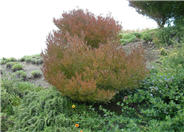
Common name:Purple Hopseed or Hop Bush
Botanical name:Dodonaea viscosa 'Purpurea'
This fast-growing shrub has an upright, branching habit that reaches a height of 12'-15', with willow-like leaves that are 4" in length. Its foliage is bronzy-green in color, which turns a reddish-purple shade in the fall and winter. It has a compact growth and requires full sun for the best results.

Common name:Century Plant
Botanical name:Agave americana
This agave is fast growing to about 6-10' tall and 8-13' wide. Wide, gray leaves have stiff terminal spines and recurved teeth on margins. It prefers full sun and well-drained situations. It is prone to agave snout weevil which will eat the roots and leaves. After blooming, which could take several years, it will die but will send up new pups from around the base. Some people are allergic to the sap. Removal is difficult if unwanted. Water once a month during the summer.

Common name:Variegated Century Plant
Botanical name:Agave americana 'Variegata'
'Variegata' has gray green leaves with a creamy yellow margin with serrated edges. This agave will grow 6-10' tall and up to 13' wide. It has a very open growth habit, with leaves that curve along their length. Tip of the leaves have a poisonous sharp spine. After 10 years or more, this Agave may send up yellow blooms, 20' tall, attracting bees and birds. Plant dies after flowering but pups may be removed to start plants.

Common name:Karl Foerster Feather Reed Grass
Botanical name:Calamagrostis X acutiflora 'Karl Foerste
This ornamental perennial grass grows 4-6' tall x 1-1.5' wide and has semi-evergreen foliage that is green in spring and summer and turns green/brown in fall. The flowers bloom in mid June and emerge a light green but quickly turn to pink/purple.

Common name:Olive, Edible Olive
Botanical name:Olea europaea
This broad tree will slowly grow to 25'-30' tall and wide. It has small, grey-green, evergreen leaves. Small white fragrant flowers bloom in spring, followed by fleshy black fruit that appears in fall. Fruit is messy and can stain sidewalks. There are cultivars that do not produce fruit. Some folks are allergic to the blooms. This tree is very long lived, with a beautiful gnarled trunk. It prefers full sun and low watering in summer months (twice a month) and none during the winter, when established.
| Designer: Mark Lewis | Inviting Pool |
Photographer: GardenSoft |
Soils and Compost:
Incorporate compost 6" into your soil to retain water, reduce compaction, feed earthworms, and provide valuable nutrients to your plants.
Water Saving Tip:
Check the soil's moisture level before watering.
You can reduce your water use 20-50% by regularly checking the soil before watering.
Integrated Pest Management:
Develop healthy soil for plants that are vigorous and naturally pest-resistant.
